The Tweeters
The selection of high-quality, sheilded tweeters in March of 1998 was darn sparce.
Only one unit from each Seas, Focal and Morel.
Vifa was the only player offering 3 choices, the
D27ASG-05 (aluminum dome), the D26SG-05 (textile dome), and the
D27SG-05 (silk dome).
Unfortunately, none of Vifa's shielded tweeters include Vifa's "tinsel leads."
The "tinsel leads" must be more flexible, more resilant to long tweeter dome excursions.
All of the non-shielded tweeters that carry this feature rate
100 watts of power handling with a 12 dB/octave crossover at 3 kHz.
Similar tweeters without these special leads are also rated at 100 watts,
but with a 12 dB/octave crossover at 4 kHz.
(It is also worth noting that all 3 shielded tweeters have lower power handling
ratings than similar, non-shielded units.
I can only speculate the cause; higher expected tweeter power levels in a home theatre environment?)
The aluminum and textile dome units have resonant frequencies about 1.5 Khz, so
the choice Vifa tweeter was the silk dome unit with a resonance of 1 kHz.
So far I have been able to evaluate the Vifa, Focal, and Morel units.
At some point I may check out the Seas unit.
It is rather expensive at $64, but looks to be a top-of-the-line tweeter with every bell and
wistle that Seas has to offer (even silver voice-coil wire).
My final selection is the Vifa, with the Morel being held for further testing
(modification of the back chamber for lower resonance).
| Model | Vifa D27SG-05 |
Focal TC90KB | Morel MDT-30-S
|
| Pic
| 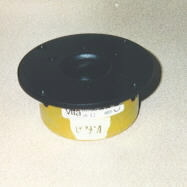
| 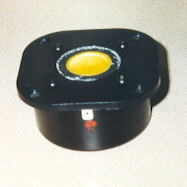
| 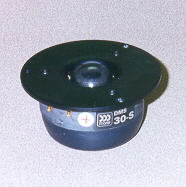
|
| Material | Silk | Kevlar | Textile
|
| Faceplate | Plastic | Plastic | Metal
|
| Ferrofluid | Yes | No | Yes [?]
|
Resonance
Frequency
(measured) | 1000 Hz (1090 Hz) | 950 Hz | 700 Hz (837 Hz)
|
| Moving Mass | 0.3 g | ? | 0.44 g
|
| BL product | 2.7 NA | ? | 3.5 NA [?]
|
| Qts (measured) | ? (0.86) | 0.90 | 0.57 [?] (0.64)
|
| Qes (measured) | ? (1.24) | 1.21 | ? (1.02)
|
| Qms (measured) | ? (2.83) | 3.47 | ? (1.71)
|
| Re | 4.6 | 5.9 | 5.2 [?]
|
| Efficiency | 92 dB | 92 dB | 90 dB
|
| Power Handling | 80W | 75W | 200W
|
Recomended
Crossover | 12dB/Oct @ 4k | 12dB/Oct min | ?
|
| VC Height | 1.6 mm | 2.2 mm | 2.7 mm [?]
|
| Gap Height | 2.0 mm | 3 mm | 2.5 mm [?]
|
| Price | $22.95 | $59 | $60
|
Notice the white stuff around the edges of the Focal tweeter.
It is from the styrofoam packaging where the surround was touching
during transportation.
I could find nothing to remove the styrofoam contamination without also
harming the foam surround.
Needless to say, I was pretty disappointed.
Testing Methodology
| Vifa | Focal | Vifa/Morel Baffle
|
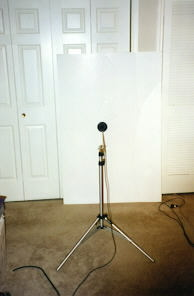
| 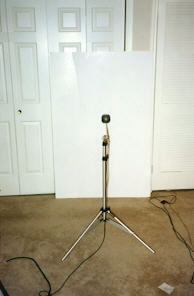
| 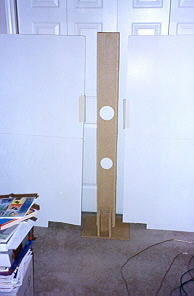
|
Shown above is the rather crude testing methodology that I began with.
The white board in the first two pictures is a 40" x 60" foam board
that can be found at any office supply store.
It is about 0.2" thick, so not particularly strong.
I glued an additional piece of foam board on the backside to stiffen up the
area around where I mounted the drivers.
The last photo shows a double layer, 1.5" thick "skinny" test baffle that
I built, the stand for it, and two more 40" x 60" foam boards.
The two white circles on the test baffle cover up the mounting holes
for the Vifa and Morel tweeters.
All the tweeters were flush mounted for the tests, as was the mid-range.
The frequency and phase responses shown below have to be taken with a grain of salt.
Later testing showed that the foam board is at least partially acoustically transparent
in the mid-range frequencies, and possibly has a mid-range resonance as well
(see The Tweeters, Part 2).
By the time I made this determination, I had already returned the Focal tweeter, so I
have not been able to verify which response artifacts are "real" and which are "foam board."
However, discussions with fellow speaker builders verified the Focal's severe
resonance problem above 10 Khz as real.
Between that, the unit's high price, and the poor arival condition, I incurred no
emotional loss returning the Focals.
Distortion measurements were all made at a distance of less than an inch
to maximize the number of valid data bits.
Since the card's sample rate is just over 40 Khz, 3rd order harmonic
distortion measurements above 7 Khz were not possible, nor 2nd order
harmonic distortions above 10 Khz.
Vifa D27SG-05 Tests
Frequency response and phase plots.
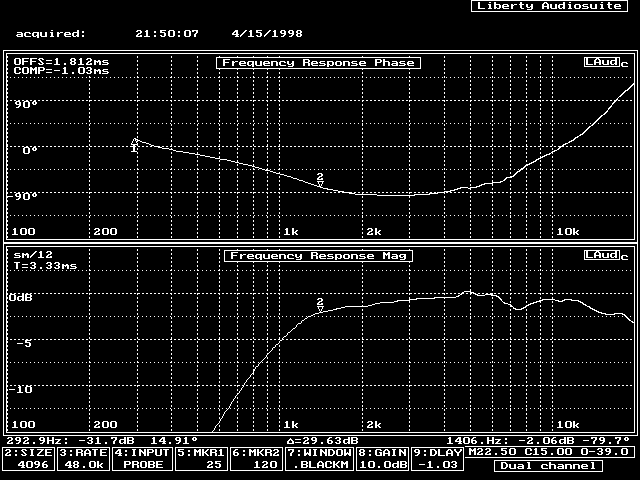
Frequency waterfall of the above.
There is some activity associated with the response dip around 7kHz.
This indicates some type of possible resonance behavior.
As mentioned in the intro, this could be an artifact of the foam board.
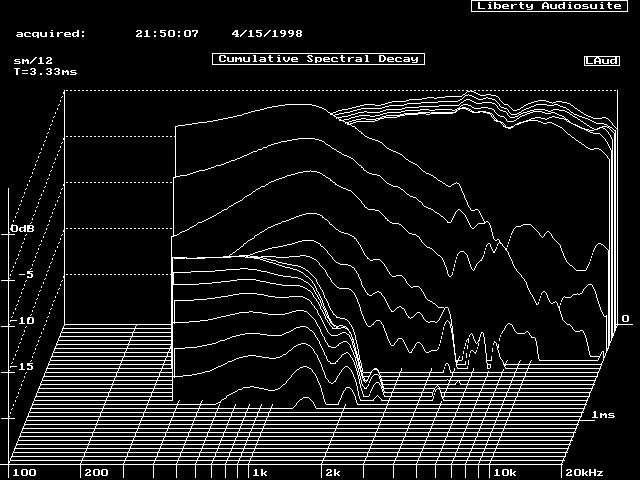
THD plot at a signal level of -19.5 dB.
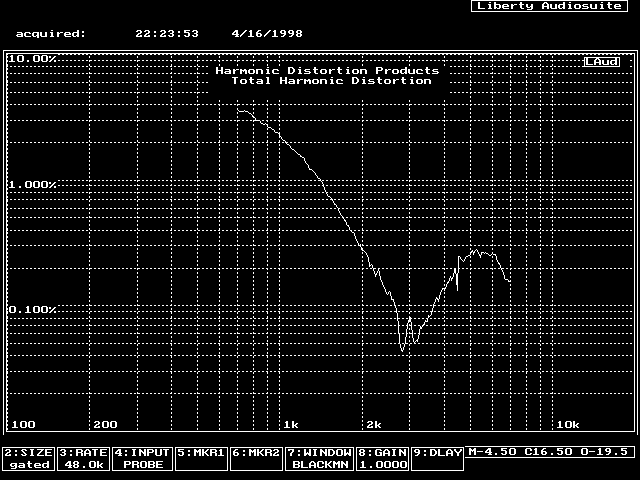
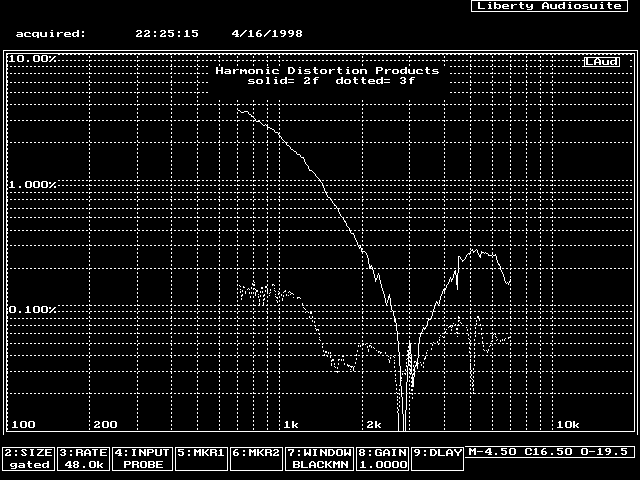
Impedance plot with a signal level of -39.0 dB measured while on prototype
cabinet 1.
This is very smooth and does not indicate any resonance behavior as
measured while on the foam board.
This smoothness is possibly the result of ferrofluid's mechanical damping.
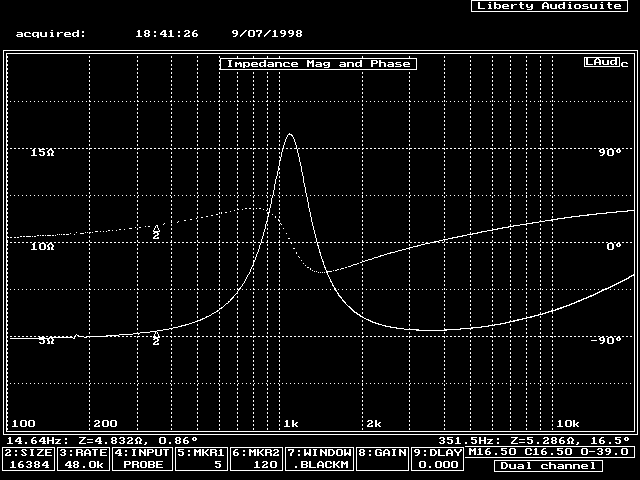
Focal TC90KB
Frequency response and phase plots.
Notice the dip at 2kHz, and the crazyness above 10 Khz.
The dip at 2 kHz is present in Focal's own response data, as is the
wierdness above 10 kHz.
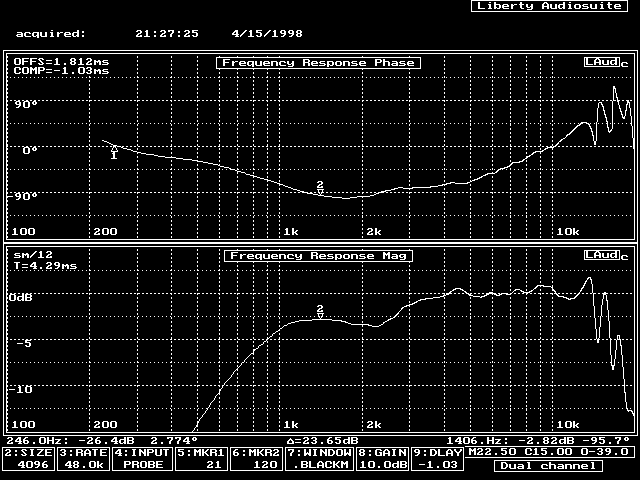
Frequency waterfall of the above.
Wow, look at the activity above 10Khz!
This is pretty bad ringing.
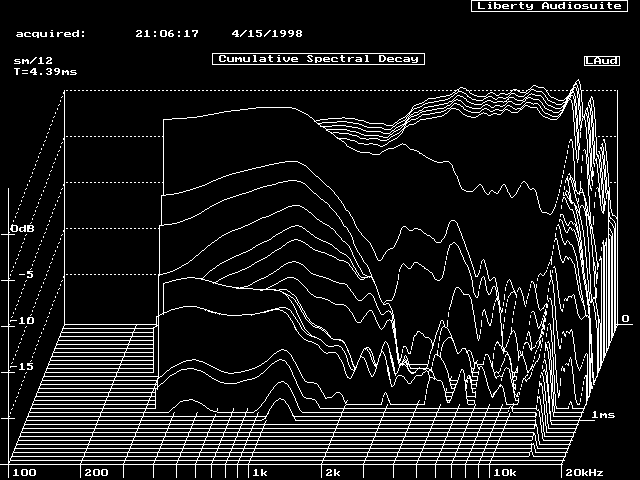
THD plot at a signal level of -19.5 dB.
Notice the Focal unit's THD is evenly distributed between the
2nd and 3rd harmonics (plot 2 of 2).
Both the Vifa and Morel units' distortions are dominated by 2nd
order distortion products.
This characteristic is maintained at lower signal levels.
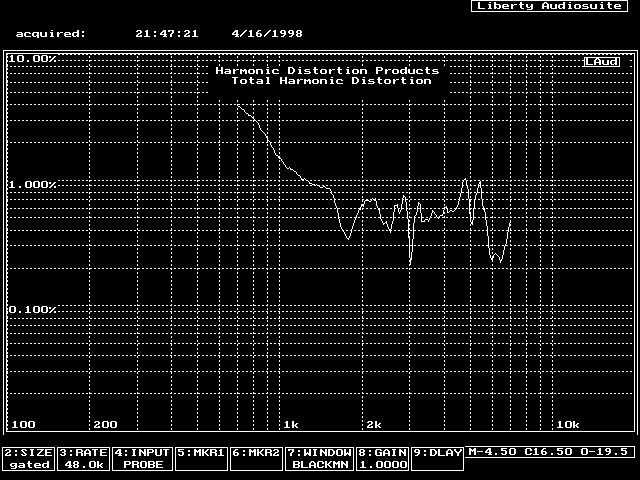
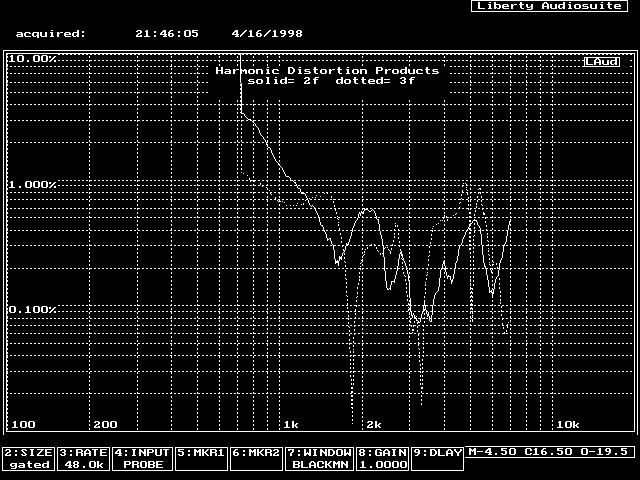
Sorry, no impedance plot for the Focal.
However, other data I recorded shows impedance anomylies
at 2.5 kHz, 5 kHz, and several above 10 kHz.
Morel MDT-30-S
Frequency response and phase plots.
Notice the small dips at 4.4 kHz and 12 Khz.
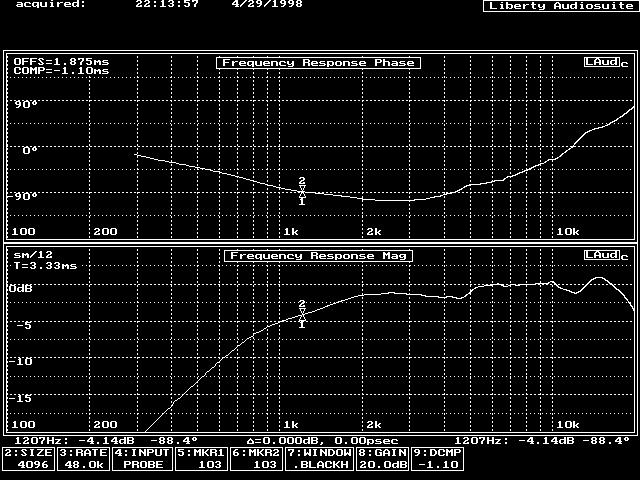
Frequency waterfall of the above.
The peaks/dips seem fairly well damped.
However, the z-axis is only 0 to -20 dB whereas on
the other drivers the range is 0 to -25 dB. :(
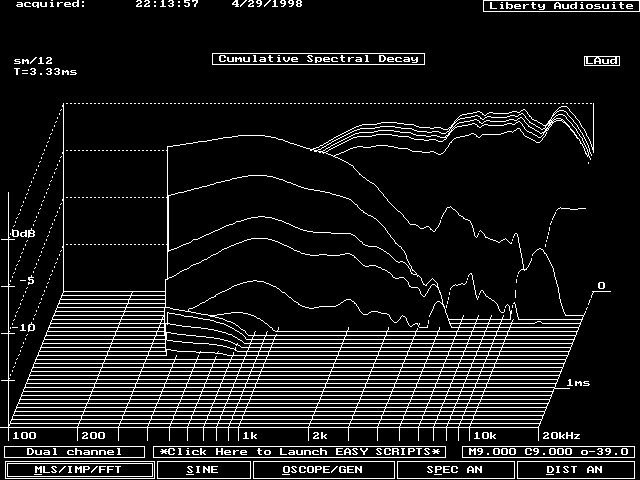
THD plot at a signal level of -19.5 dB.
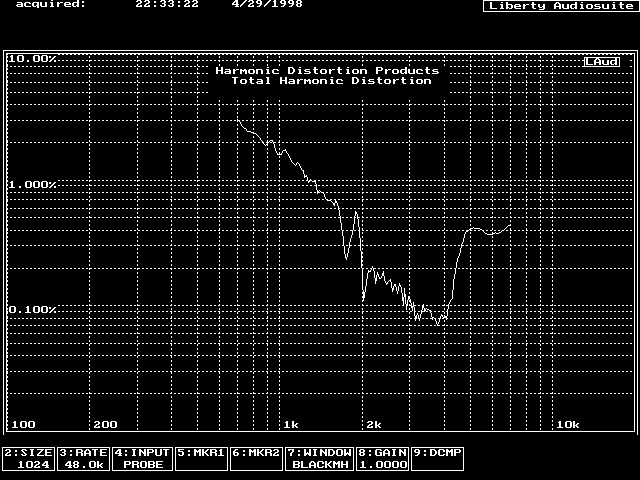
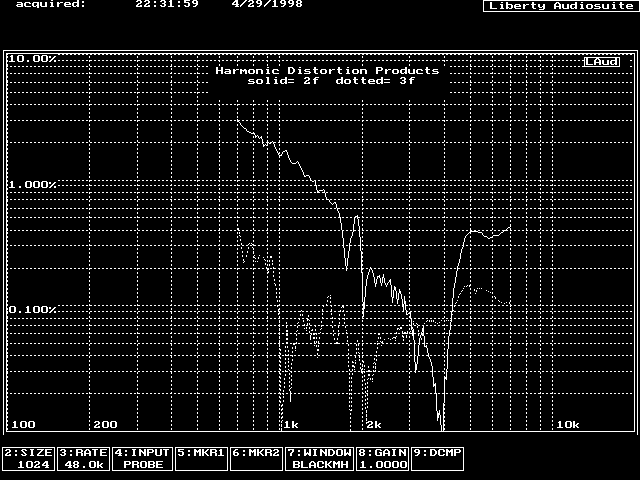
Impedance plot at a signal level of -39.0 dB.
Note the anomyly around 12-15 kHz.
There is also an anomyly around 5 kHz, but it is much more subtle.
This indicates a mechanical resonance in the system which can store energy.
At higher test signal levels the anomylies are more pronounced.
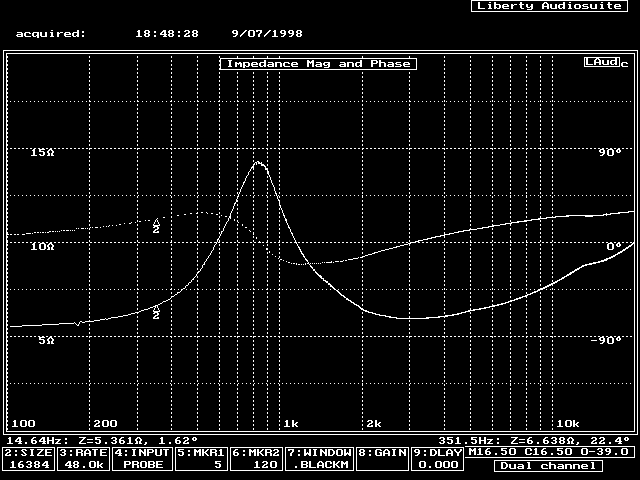
Copyright © 1998,1999 John Lipp



















